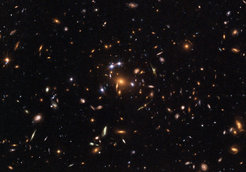Taking the Temperature of Dark Matter
Warm, cold, just right? The analysis of seven strongly gravitationally lensed quasars gives new clues about the temperature of dark matter, the mysterious substance that makes up about a quarter of our universe. The results put a lower limit on the mass of a potential dark matter particle while not ruling out cold dark matter.

This image shows a distant quasar being lensed due to gravity into five images. The galaxy cluster creating the lens is known as SDSS J1004+4112 and is one of the more distant clusters known (seven billion light-years, redshift z=0.68). Astronomers are using this phenomenon to learn more about the properties of dark matter.
We have very little idea of what dark matter is, and physicists have yet to detect a dark matter particle. But we do know that the gravity of clumps of dark matter can distort light from distant objects. MPA scientists and their colleagues at UC Davis are using this distortion, called gravitational lensing, to learn more about the properties of dark matter.
The standard model for dark matter is that it is ”cold,” meaning that the particles move slowly compared to the speed of light. This is also tied to the mass of dark matter particles. The lower the mass of the particle, the “warmer” it is and the faster it will move.
The model of cold (more massive) dark matter holds at very large scales but but it is unclear if models including “warm” dark matter are preferred on the scale of individual galaxies. “Hot” dark matter with particles moving close to the speed of light has been ruled out by observations.
A limit on the mass of dark matter
The astronomers now used gravitational lensing to put a limit on the warmth and therefore the mass of dark matter. They measured the positions and brightness of seven distant gravitationally lensed quasars to look for changes caused by additional intervening blobs of dark matter. Their lens models included both stellar discs and luminous satellites as well as low-mass dark matter haloes located along the observed lines of sight for the first time. The scientists used these results to measure the size of these lenses and found that about 1% of mass can be found in such dark matter substructures. If dark matter particles are lighter, warmer and more rapidly moving, then they will not form structures below a certain size.
The results put a lower limit on the mass of a potential dark matter particle (mth > 5.58 keV, i.e. at least the energy level of nuclear fusion systems) while not ruling out cold dark matter. The team’s results represent a major improvement over a previous analysis, from 2002, and are comparable to recent results from a team at UCLA. Adding more lensed objects to the survey will improve the statistical accuracy in the future.








